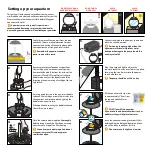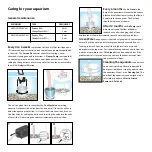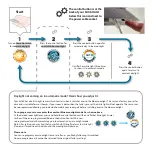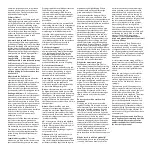
Why do I have to change the filter cartridge
so often?
The filter cartridge works like a waste bin and
will eventually become ‘full’. By regularly
changing the cartridge everything it has
absorbed is removed from the aquarium,
just like taking your household waste bin out
to be collected. For optimum filtration the
filter cartridge should be replaced every
4-6 weeks.
Can I wash the sponge?
If the sponge gets dirty before a change is
due it can be washed. However the
chemicals in the filter cartridge only remain
‘active’ for 4-6 weeks. Therefore the cartridge
should be replaced.
What does the filter cartridge contain?
The filter cartridge contains activated
carbon and resins that should be removed
before using aquarium medications. Leave
the sponge in the cartridge to continue
trapping dirt and replace with a new
cartridge when the treatment period is
over.
Do I have to keep the ceramic media
provided?
The ceramic media provides essential
biological filtration. It is your fish’s toilet and
bacteria will colonise the media to consume
toxic fish waste making the water safer for
your fish to live in. Without this the water
would quickly become very polluted.
Can I put aquarium gravel in the aquarium?
It is not recommended to put gravel, sand or
small stones in a biOrb. Gravel is likely to
block filtration and may become lodged in
the filter cartridge casing.
Will changing the cartridge kill the filter
bacteria?
No. The filter cartridge provides mechanical
and chemical filtration. Biological filtration is
provided by the ceramic media, so not
affected by the filter cartridge.
Why do I have to keep the aquarium out of
sunlight?
Strong daylight can encourage excessive
algae growth and cause temperature
fluctuations within the aquarium making life
uncomfortable for fish.
Can a heater be added to the aquarium to
make it tropical?
A 50W heater can be added to the aquarium
with the aid of a heater stand.
Can I use a longer airline?
Air line longer than 3-5 metres will require a
larger air pump. Attach new airline to the
pump end of the existing airline, not the
aquarium end. Trim the end of the tube you
detach from the pump and use either a
straight airline connector, or better still a one
way valve.
Why am I getting fewer bubbles?
If you have noticed that there are fewer
bubbles you may need to change the air
stone. Alternatively if you have just changed
the filter cartridge, air from the sponge may
be trapped inside the cartridge. Twist the
bubble tube and lift one side of the filter
cartridge slightly to allow the air to escape.
What happens if the pump stops?
It is advisable to keep a spare air pump.
Without oxygen filter bacteria will start to die
and the water may become polluted. If you
have live plants remove these from the
aquarium at night so that they do not take
oxygen away from your fish. Do not feed
your fish for a few days. It is advisable to test
the water after a noticeable power cut to see
if water changes are necessary. After a power
cut it is essential that the air pump is raised
well above the aquarium water level as per
air pump instructions.
Why is the pump noisy?
Noise from the pump is usually caused by
vibration against the surface it is on. Place
the pump on a softer surface like a mouse
mat or hang the pump up. Make sure the
airline is pushed into the air pump as far as it
will go.
Why have real plants?
There are several benefits to growing real
plants in the aquarium. Plants feed off nitrate
and phosphate, helping to keep levels low
and algae at bay. They also provide hiding
places for fish, add interest to their
environment and a tasty snack for some fish.
What type of plants?
Unless you convert your aquarium for plant
growth some species can be very difficult
to grow. Trial and error is often the only
way to find good plants for your aquarium.
Try inexpensive bunches of hardy plants to
begin with. Fast growing stem plants like
Elodea densa or Cabomba aquatica, often
sold as ‘goldfish weed’ or ‘oxygenators’ take in
nutrients through their leaves rather than
roots. They will fight with algae for food and
cope with well filtered aquariums. Generally,
fish like to graze on soft, bright green plants.
Tougher varieties, or fast growing plants
usually withstand the attentions of fish,
however some fish will destroy any plant.
Very bright green or red plants generally
need more specialist lighting in order for
them to thrive. Selecting several plants of
different heights will add interest to the
aquarium for you and your fish. Buy plants
that are fresh and healthy.
Do plants oxygenate the water?
During daylight hours plants use carbon
dioxide and release oxygen into the water.
When it is dark however they do the
opposite, this is why plants shouldn’t be
used to oxygenate aquarium water. Make
sure the plants you buy are ‘aquarium plants’
Frequently asked questions
and not varieties sold for ponds.
Artificial plants
- Plants can be difficult to
grow and many people prefer to choose
artificial aquarium plants. There are many to
choose from, usually made from plastic or
silk, and can look very realistic. Although
they do not have the benefits of live plants
they never die and can be taken out and
washed when dirty.
Fixing plants in the aquarium
- Plants are
usually sold in pots or bunches; both can
restrict the growth of the plants. Pots must
be removed, the substrate used around the
roots can cloud the water. Most stem plants
can be kept in their bunches as long as they
are regularly taken out and trimmed.
Use the ceramic media in your aquarium to
anchor plants into position. Remove 5-6
rocks, insert the plant into a gap and then
place the rocks around the plant to secure it.
Single stems can be fed in-between the
rocks quite easily. Plants with good root
systems, such as Cryptocornes and java fern,
can be loosely tied onto bogwood or
aquarium rock with fishing line. These plants
should then grow onto the surface. This
makes it easier to position the plants and lift
them out of the water.
Aquarium gardening
- Most plants do not
need much care. However, a little gardening
during normal aquarium maintenance will
keep plants looking their best. Dead leaves
should be removed as soon as you see them
otherwise they will rot and pollute the
water. Take dead leaves off cleanly close to
the stem. If a plant dies creating a lot of
mess care should be taken to remove all of
the plant, if left in the aquarium it may cause
poor water quality and algae problems
which will be harder to rectify later on.
What fish can I keep?
There is a good choice of cold water fish
available and tropical fish can be kept if an
aquarium heater is fitted inside the aquarium.
The suitability of fish depends on their adult
size, behaviour and requirements. It is
recommended that you start with a hardy
species, consult you local aquarium store for
suggestions. Non-hardy fish such as Neon-
Tetra or Blackmoors are not recommended
for the first month. Hardy fantail goldfish are
a good choice for biOrb/biUbe aquariums.
Fantail goldfish have long tails that look like
two tails joined together. Their bodies are
short and round. Avoid fancier varieties such
as bubble eyes and pearl scales which can
be harder to care for or Orandas that can
grow too big.
Common goldfish are fast swimming and
boisterous, they shouldn’t be mixed with
fantail goldfish and are better suited to very
large aquariums or ponds. Common
goldfish, such as comets and shubunkins
usually have a single flat tail and cigar
shaped bodies. Smaller cold water fish such
as white cloud mountain minnows make
good first fish, a shoal of six can be mixed
with fantail goldfish.
Temperate fish can be kept without a heater
providing you use a thermometer to check
that the temperature in the aquarium does
not drop below 19°C (17°C at night). These
can include danios, some guppies and
platys amongst others. Only buy fish that
have already been acclimatised to cool
water. These shouldn’t be mixed with
goldfish.
DO NOT
keep ‘bottom feeding’ fish, such as
common pleco, loach or catfish in
biOrb/biUbe aquariums. The ceramic media
used for biological filtration is unsuitable for
them. Many of these species also grow very
large.
There is a large variety of small tropical fish
that can be mixed together or kept as a
large shoal of one species. As with any pet,
before buying you should do a little
research into your chosen fish from the
wealth of fish books or websites available.
Check that the fish you buy will be
compatible with your existing fish and/or
the fish you plan to have. They should be
healthy and alert, scales should be smooth
and not damaged or infected.
With fantail goldfish in particular check that
they are swimming easily (not sideways or
up-side down) and that their tails are not
held at an abnormal angle. Don’t be afraid
to reject a fish that you do not think is
healthy. If you are not completely happy
with it don’t buy it.
Getting your new fish home
- Moving to a
new aquarium is a very stressful experience
for fish. This can be too much for them and
some do not survive. By planning your
purchase and taking care you can minimise
this stress to give your fish a better chance
of enjoying their new home. Always make
sure that the fish you buy can be taken
straight home to your aquarium. When
travelling, keep the fish steady, secure and
out of direct sunlight. The fish bag should be
covered with a paper bag or box to reduce
stress and help tropical fish maintain their
temperature. At home, open the bag and
roll down the sides like a sock. Equalise the
temperature in the bag and the aquarium
by floating the open bag on the water
surface for 30 minutes. Carefully tip the bag
to allow the fish to swim out. Try to minimise
the amount of water from the bag entering
the aquarium. Leave the aquarium light off
and do not feed for a day or two. Like any
pet you should research the needs of the
fish you want before taking them home.
What to feed
- Good quality prepared fish
foods provide a well balanced diet but fish
will relish a variety of foods. Fantail goldfish
in particular will benefit from a varied diet.
Daphnia, brine shrimp or bloodworm are
enjoyed by most fish and can be purchased
Содержание 48469
Страница 1: ...English Français Deutsch Nederlands ...









